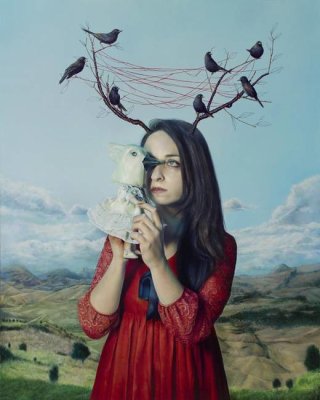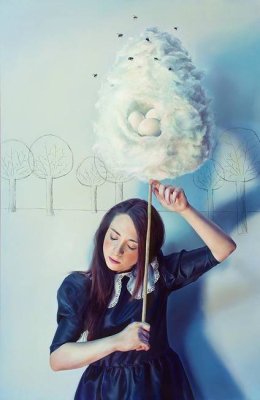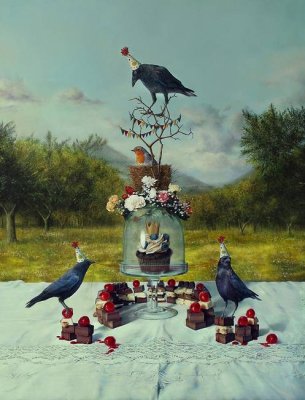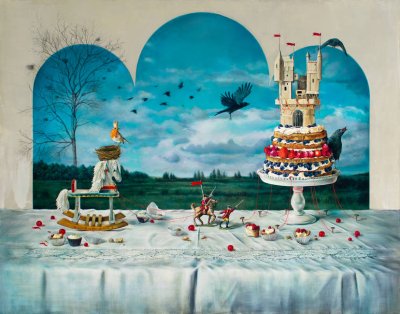ELISA ANFUSO. EYES WIDE SHUT
 06 October 2019–27 October 2019
06 October 2019–27 October 2019
The Exhibition
“Eyes wide shut” is an oxymoron – “eyes open shut” – and to give a stronger meaning in Italian by using an adverb we could translate it as “eyes openly shut”. Peculiar to this rhetorical device is the friction originating from the antinomy of the two opposite words and which, in turn, is expressed by a semantic short-circuit because “one of the two terms expresses a meaning contrary or contradictory vis-à-vis the meaning of the other one, while they both represent a syntactic function”. An oxymoron has not certainly the evocative potential of a metaphor which stands, not by chance, at the beginning of the language and is one of the favourite tools of poets; although, if it is pretty “brilliant” and “insane” (as suggested by the etymon) it has its reason to be; thanks to its paradoxical nature it causes a cognitive amazement which leads to a reflection or, at least, to a careful second reading.
What can we see with our eyes “openly shut”? And if “eyes wide” literally refer to open eyes, can they be open and “shut”, closed, at the same time? And what does it mean this being so widely available to closure? or what does it mean such a strong and intense closure to become a new opening? Kubrick proved to be a genius in choosing the title for a movie which is disappointing (in its Hollywood nature) at first viewing whereas it is acknowledged as masterpiece in later reviews, as all the other few films signed by the American director. And it is even more understandable if we think that the script merely transposes (it is only set in a different period) a novella by Arthur Schnitzler, dated 1925/26, whose original title in German is a more anodyne “Traumnovelle”, the dream story.
A short digression which is useful to analyse, later, the critical question about Elisa Anfuso's work, who – in this exhibition – proposes a number of pictures of cold beauty. As a matter of fact, until 1924, Schnitzler believes the novella should be called “Doppelnovelle”, “Double story”, because it tells the story of “a diagram of analogous restlessness”, the crisis of the two protagonists, a husband and a wife, “facing the puzzling and uncertain reality of existence”. Albertine and Fridolin, in a sort of dreamlike-surreal suspension, imagine and try to betray each other, jeopardizing the couple loyalty and domestic tranquillity in a sort of challenge. They open a gap in their relationship which cannot be filled by the comforting ending. The Viennese writer, in a few lines, outlines with merciless clarity of mind that “kind of middle land between the conscious and the unconscious”, that he will define as “middle consciousness” (a definition that we have to bear in mind for later).
Just like “Doppelnovelle”, the French and the Italian translations adopted the title “Double dream” (“Doppio sogno” - “Double rêve”), which is substantially a crasis between the first “doppel” and the second “traum”, and which clarifies even better what the story aims at investigating. The “dream” issue is not secondary and this is where Sigmund Freud's interest in Schnitzler's work, in general, and the mentioned novella, in particular, comes from, since – in those years and in the same city – he was perfecting his theory about the dreams (already structured in the fundamental work “Die Traumdeutung” dated 1900).
The father of psychoanalysis is intimidated by the writer's natural introspective ability, by his “refined self-exploration”, who allows him to disclose the prerequisites, the interests, the results that usually would stem from a laborious scientific research. On the other hand, the writer doubts the dogmatism of psychoanalysis and he considers the strict dichotomy, so dear to Freud, between conscious and subconscious as inaccurate, by introducing a third party, the so-called “middle consciousness”, which would be “the larger territory of the psychic and spiritual life; the elements continuously flow from there to the conscious or fall into the unconscious”: and it is a primary duty of arts and of the artist to investigate this.
This long introduction is useful not only to explain the title of the exhibition, “Eyes wide shut”, after the film presented 20 years ago, in September 1999, to Venice Festival, a few months after Kubrick's death, but also to define Elisa Anfuso's painting work. It would be too easy and unfair to use the word “dreamlike” to describe her paintings, or to associate her with the long list of surrealist artists who merely pursued psychoanalysis with other means; and we cannot even recall the genre “fancy” (wonderland) that spans from the 18th century to today without any evolution in terms of style or contents, except for the obvious modernization of the lines. On the contrary, Anfuso's images, floating between real and surreal, perfectly represent that “middle-consciousness” so dear to Schnitzler, who rejected the mistake of those who insist in digging up in the depth of the unconscious more than necessary, “perpetually inspecting”.
Being in the middle gives a refined lightness to Anfuso's scenarios, which go beyond the limits of the real but they never fall into the shades of nightmares; there is a rarefaction, a temporal suspension, even in the precise hyperrealist lines fundamental to the Sicilian artist, which expresses the reality and the dream at the same time, the truth with the lie, hendiadys essential to our life and that cannot be limited to a unum. It is just like transforming the everyday life with the imagination, taking on some bizarre – but not impossible – features, and this transfiguration takes place by gathering symbols (the egg, the birds, the flowers, the cherries...) until it acquires the ambience of a symbolist painting. Even colours support this symbolic feature: from white to red, from albedo to rubedo, without going through the dark inquietude of nigredo, Anfuso's alchemical path is fulfilled up to the “sublimation”, which – if it means the passage to an airy form in chemistry – in psychoanalysis is the transformation of primordial impulses, so that an aggressive sexual drive – Freud would maintain – is normalised into a non-sexual or non-aggressive goal.
Therefore: Anfuso's teenagers and women keep a certain erotic charge, their postures reveal a kind of child's restlessness, but nothing flows in the cold composure of the shapes and in the clear lines, and the sensations are channelled, traced back, into a path of almost normality. There is obviously the staging of the background, the captivating fancy posture, the extravagant clothes and headgear rich in laces and, needless to say, the presence of cakes is not a tribute to the pastry-making art of the artist's country of origin, but rather the passage from eros to gluttony, that is, from the not-possible-to-tell to the allowed-to-show. In addition to this, in her latest production, there is the issue of the double, from a feminine standpoint, which duplicates, like in a mirror, the profound existential surface of the women on stage: Freud reluctantly wrote to Schnitzler: “I think I avoided you out of a kind of fear of encountering my double”, and we can understand this fear because the similarity, or rather the identicality which undermines and denies the identity, is scaring and shocking since we irremediably find ourselves in the other.
Anfuso's blindfolded girls are not blind: they are looking into themselves and for this reason they must have eyes “openly shut” to the outside, so that they can be “tightly open” on the inside. This seems only an insignificant stylistic by-product of the oxymoron mentioned earlier, but this time it happens to be the truth of things.




